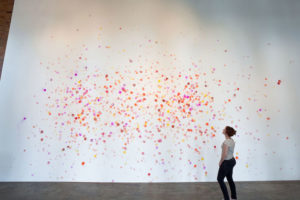Michael Beitz and Matt Monroe, Patrick Brennan, Rick Caruso, Center for Urban Pedagogy, Jillian Conrad, Nathan Gwynne, Katy Higgins, Kim Hoeckele, Ellie Irons, Rena Leinberger, Carlota Mazon, Andrew D. Moeller, Heidi Neilson, Birgit Rathsmann, Erin Thurlow, Eugenie Tung,
and Jeff Williams.
Special Performance:
Thursday, July 7 at 7pm
The Ice Machine and Swift
In the New York summer, escalating temperatures alter the shape and feeling of everyday life. Pavement sweats. Air stagnates; the pace slows, tensions rise. The city’s combination of structures, surfaces, and inhabitants creates a heat trap, also known as the “urban heat island effect.” The causes of the urban heat island, according to William Lowry’s 1967 article “The Climate of Cities,” are many: rocklike surfaces, a maze of built shapes and reflectors, contaminated air, the lack of cooling evaporation from channeled water, and the city’s own heat sources (factories, vehicles, air conditioners, people). Eschewing strict thematic divisions, the exhibition Heat Island takes these factors as a starting point for further investigation, suggesting an imaginative mode for exploring the hot city.
Concrete and rubble, mirrors and windows suggest a reflective, heat-amplifying terrain. Bisecting the main gallery, Erin Thurlow’s Broken Window Brick Wall appears both solid and transparent, exploring the potential of an incongruous mirage to create irreducible, often funny, perceptual experiences. Images of urban ruin inform Rena Leinberger’s simulations of debris, which explore processes of construction and entropy. In her sculpture, what appears as a pile of rubble or the detritus of a leaking roof is a complex staging of site and representation. A composite concrete slab by Jeff Williams results from the artist’s lo-fi experimentation with materials. Stress fractures line the concrete, revealing unseen forces caused by an object wedged inside.
A transformed landscape of manmade, heat-absorbing matter is conjured through form and allusion. Newtown Creek pollution yields luminous abstractions in Kim Hoeckele’s photographs, which document this Superfund site’s ecology through otherworldly images. The collision of reflective and dull surfaces creates delicate balance in Patrick Brennan’s casual installation of abstract paintings, asserting an everyday language of inventive shape-making.
Several works evoke the heat of social exchange. Nathan Gwynne’s drum sculptures tread the line between the formal and the performative, incorporating urban detritus such as a concrete block and a police barrier. Birgit Rathsmann’s mural-sized wall drawing is all that is left of an earlier tennis tournament, using colorfully pigmented tennis balls to record traces of action. Eugenie Tung’s installation covers household refrigerators with magnets made from photos of windows, collected for months via Kickstarter.com, turning this everyday appliance into a mini-building reflecting participants’ experiences. Michael Beitz and Matt Monroe’s oversized fan/chair offers humorously ineffectual respite from the summery city stewing outside.
In the back gallery, individual subjects come into sharper focus. Heidi Neilson isolates the alien terrain of Queens rooftops in a series of etchings. Disassociated from context and floating against the paper’s ground, features such as skylights, chimneys and antennae reveal the strange geometry of the city seen from above. In a series of modular paintings, Andrew D. Moeller creates deadpan, detailed renderings of banal building facades. Katy Higgins’ Kensington Gardens photographs capture the staging of nature in her Brooklyn neighbors’ front yards. A precarious assembly of cinder blocks, wood, paper, and other materials in Jillian Conrad’s sculpture A Piebald Horse harmonizes with Rick Caruso’s small drawings, painting, and collage. Both artists’ work use playful color and detail to move fluidly between poetic abstraction and reference to the cityscape.
Video in the exhibition addresses the city’s ecology through researched exposition and image-based approaches. Exposing the conditions of New York’s subterranean water and waste systems, the Center for Urban Pedagogy’s documentary The Water Underground (2005) here enters into conversation with lyrical, short videos by Ellie Irons, Carlota Mazon and Heidi Neilson, which consider aspects of the city – the watershed, the skyline, and a skyscraper’s relation to sun and shadow, respectively – from surprising, highly individualized viewpoints.
Connecting materials with behaviors, Heat Island creates a microcosm of the hot city, sampling its surfaces and structures, and evoking residents’ relationship to the built environment.
Photo by Kim Hoeckele, Untitled (Methane), (detail), 2010, Digital C-Print, 30×30 in.
This exhibition is made possible with public funds from the New York City Department of Cultural Affairs and the New York State Council on the Arts, celebrating 50 years of building strong, creative communities in New York State’s 62 counties and with support from The Concordia Foundation and Smack Mellon’s Members.
Smack Mellon also receives generous support from The Andy Warhol Foundation for the Visual Arts, National Endowment for the Arts, The New York Community Trust, The Greenwall Foundation, The Robert Lehman Foundation, Jerome Foundation, Lambent Foundation Fund of the Tides Foundation, Bloomberg, The Greenwich Collection LTD, Milton and Sally Avery Arts Foundation Inc., Helena Rubinstein Foundation, Brooklyn Community Foundation, 2010 JPMorgan Chase Regrant Program administered by the Brooklyn Arts Council, The Mary Duke Biddle Foundation and Foundation for Contemporary Arts.
Space for Smack Mellon’s programs is generously provided by the Walentas family and Two Trees Management.


